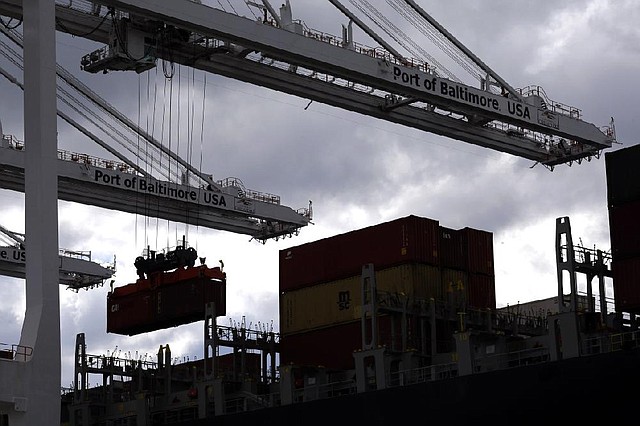U.S. trade deficit dips in February
Work hums along at the Port of Baltimore’s Seagirt Marine Terminal. The U.S. trade deficit narrowed in February, the Commerce Department said Friday.
Saturday, April 6, 2013
WASHINGTON - The U.S. trade deficit unexpectedly narrowed in February as exports climbed close to an all-time high and the volume of imported crude oil fell to the lowest level in 17 years.
The gap between exports and imports shrank to $43 billion in February, down 3.4 percent from January’s revised $44.5 billion, the Commerce Department said Friday. It was the smallest trade imbalance since December when the gap had declined to $38.1 billion, the lowest point in nearly three years.
Exports rose 0.8 percent to $186 billion, close to the record high set in December. Stronger exports of U.S. energy products and autos offset declines in sales of airplanes and farm equipment.
Imports were flat at $228.9 billion with the volume of crude oil falling to the lowest point since March 1996.
The politically sensitive deficit with China shrank to $23.4 billion, the lowest point in 11 months. Exports to the European Union were down 0.9 percent in February, compared with January, reflecting continued economic weakness as that region struggles with a recession triggered by a debt crisis.
Through the first two months of this year, the U.S. deficit is running at an annual rate of $524.5 billion, down slightly from last year’s $539.5 billion imbalance.
“Global markets are holding up well” even as “Europe is struggling to right its economy,” Ryan Sweet, a senior economist at Moody’s Analytics Inc. in West Chester, Pa., said before the report. “Domestic demand is improving in the U.S. so that’s going to increase imports.”
Economists expect the deficit this year will narrow slightly, in part because of continued gains in U.S. energy exports. A narrower trade gap increases growth because it means U.S. companies are earning more from overseas sales while U.S. consumers and businesses are spending less on foreign products.
The economy as measured by the gross domestic product grew at an annual rate of 0.4percent in the October-December quarter. Economists believe economic growth strengthened in the January-March quarter to around 3 percent.
In addition to increases in U.S. energy exports, economists are also hopeful that exports of other products will rise this year as well, helped by stronger growth in some major export markets.
That forecast is based on an assumption that the European debt crisis will stabilize, helping increase exports to that region and that growth in Asia will rebound further. The outlook for Europe has been clouded in recent weeks by a flare-up of financial problems in Cyprus and raised new worries about the danger that the debt troubles could destabilize more European nations.
For all of 2012, the trade deficit with China increased to $315.1 billion, the largest imbalance ever recorded with a single country. The high deficits with China are adding pressure on President Barack Obama’s administration to take a harder line on China’s trade practices. Some U.S. manufacturers contend that China keeps the value of its currency artificially low to make its exports to the U.S. cheaper.
Treasury Secretary Jacob Lew traveled to Beijing last month on his first foreign trip since taking over the Treasury job from Timothy Geithner. Lew discussed a variety of trade issues including currency, copyright piracy and computer hacking. In his talks with the Chinese, Lew drew a distinction between criminal Internet attacks, which are a common threat, and spying by state-sponsored enterprises. The White House has called on China to take action to stop computer attacks aimed at stealing company secrets.
Production of oil and natural gas has been rising in the United States because drillers have learned to tap once-inaccessible reserved trapped in shale formations. New techniques such as horizontal drilling and hydraulic fracturing, or fracking, have made this possible.
Increased production has lowered U.S. prices of crude oil and natural gas, which refiners use to make gasoline, diesel and other fuels. Crude in the U.S. has been selling for $20 per barrel cheaper than international crude. With lower input costs, U.S. refiners are making enormous amounts of petroleum-based fuels and selling them on the international market at a huge profit.
Information for this article was contributed by Shobhana Chandra and Alex Kowalski of Bloomberg News.
Business, Pages 27 on 04/06/2013
